新编国际商务英语函电教学资料layout_of_a_business_letter
- 格式:ppt
- 大小:1.78 MB
- 文档页数:26
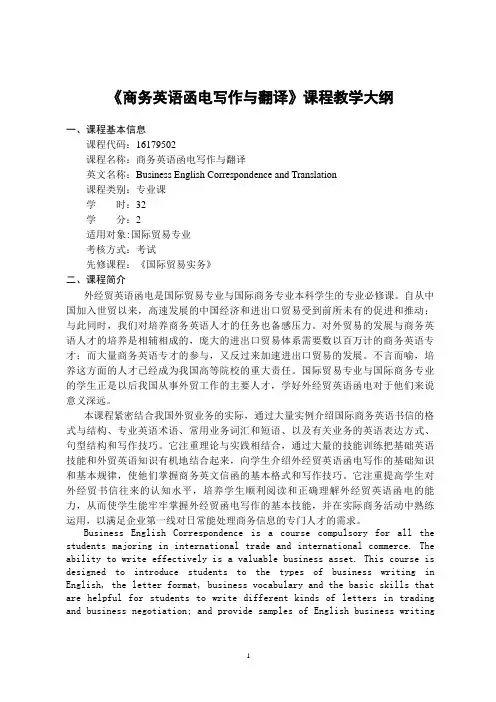
《商务英语函电写作与翻译》课程教学大纲一、课程基本信息课程代码:16179502课程名称:商务英语函电写作与翻译英文名称:Business English Correspondence and Translation课程类别:专业课学时:32学分:2适用对象:国际贸易专业考核方式:考试先修课程:《国际贸易实务》二、课程简介外经贸英语函电是国际贸易专业与国际商务专业本科学生的专业必修课。
自从中国加入世贸以来,高速发展的中国经济和进出口贸易受到前所未有的促进和推动;与此同时,我们对培养商务英语人才的任务也备感压力。
对外贸易的发展与商务英语人才的培养是相辅相成的,庞大的进出口贸易体系需要数以百万计的商务英语专才;而大量商务英语专才的参与,又反过来加速进出口贸易的发展。
不言而喻,培养这方面的人才已经成为我国高等院校的重大责任。
国际贸易专业与国际商务专业的学生正是以后我国从事外贸工作的主要人才,学好外经贸英语函电对于他们来说意义深远。
本课程紧密结合我国外贸业务的实际,通过大量实例介绍国际商务英语书信的格式与结构、专业英语术语、常用业务词汇和短语、以及有关业务的英语表达方式、句型结构和写作技巧。
它注重理论与实践相结合,通过大量的技能训练把基础英语技能和外贸英语知识有机地结合起来,向学生介绍外经贸英语函电写作的基础知识和基本规律,使他们掌握商务英文信函的基本格式和写作技巧。
它注重提高学生对外经贸书信往来的认知水平,培养学生顺利阅读和正确理解外经贸英语函电的能力,从而使学生能牢牢掌握外经贸函电写作的基本技能,并在实际商务活动中熟练运用,以满足企业第一线对日常能处理商务信息的专门人才的需求。
Business English Correspondence is a course compulsory for all the students majoring in international trade and international commerce. The ability to write effectively is a valuable business asset. This course is designed to introduce students to the types of business writing in English, the letter format, business vocabulary and the basic skills that are helpful for students to write different kinds of letters in trading and business negotiation; and provide samples of English business writingand lots of exercises for students to help them improve their written English and let students know how to write a letter to achieve a special purpose.Since the implementation of the policy reform and opening to the outside world, foreign trade has been rapidly developed. China’s entry to the WTO has also added much greater impetus to this tendency. At the same time, the keen competition in the international market keeps on reminding us the importance of the English language in the economic development of our country. The pressing situation in international trade calls for a very urgent need of more and more professionally competent personnel in this field who have a good command of business English.Business English correspondence is regarded as an indispensable weapon, with which we can win greater success in the struggle of international trading competition in a global scale. Business English correspondence is also a firm’s silent salesman, a messenger of goodwill, representing its close interest in the outside world. Therefore, no one will deny that effective business writers can use their skill to help increase their company’s sales and profits.三、课程性质与教学目的本课程属于国际贸易与国际商务专业本科学生的专业英语必修课,是为培养商务英语人才而设立的一门重要课程。
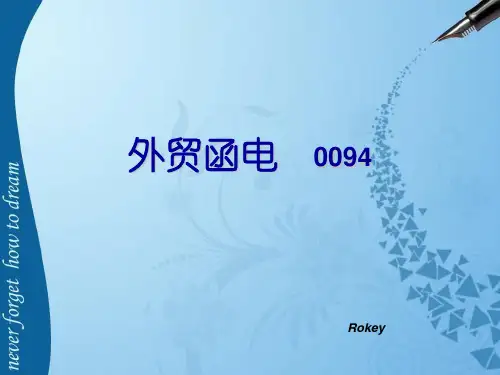

外贸函电课程教案课题:Basis of Business Correspondence课时:周次:授课日期:地点:授课方式及手段:Lecturing, Task-based approach, Questioning, Discussion …教学目标:After studying this part, the students are able to:A. Learn the structure and the format of business letters, envelopes and s;B. Learn basic principles of effective business letter-writing;C. Know the designing of a standardized letter and an ;D. Master the correct arrangement of various parts of a business letter and ;E. Practice writing business letters, s and envelopes.教学重难点:A. the Layout of Business LettersB. the Structures of Business Letters教学过程与容:Part 1 The Structure of Business LettersStep One warm-up1)Have you written a letter in Chinese? Who do you write to? How do you write?2) Have you written a let ter in English? What’s the differences between Chinese letter writing and English letter-writing?3)Do you think letter writing is very important in business? Why?Come to the introduction:The letter is a common communication medium. There are several reasons:1) A letter establishes a record that can be used for later reference2) Distance can be spanned at relatively small cost3) Routine matters can be completed efficiently with the help of letter forms.Step Two PresentationA. The layout of a business letter (商业信函的布局)Business letters will involve the following parts:(1) Letter Head /Heading Section (信头)(2)Reference Number and date Line(案号和日期)(3)Inside Address/the inside name and address (封地址)(4)Attention Line (注意事项)(5)Salutation /The Greeting (称呼)(6)the Subject Line /Subject-matter/the Subject Heading (事由)(7)the Body of the Letter (正文)(8)complimentary close/ the Closing (结束礼词/结尾敬语)(9)signature section / the signature (签署)(10)The identification Initials /the Reference Notation (经办人代号/主办人代号)(11)The Postscript—P.S. (再启)(12)The Enclosure (附件)(13)The Carbon Copy/ Carbon Copy Notation (抄送说明)Business letters usually consist of :seven standard parts (标准/规部分)six optional parts (任选部分)B.Explanation of letter parts (信的各部分的解释)Step Three consolidationAsk them to recognize all parts in a business letter. Using the given letter, find out each part of a business letter:Step Four HomeworkLearn the Chinese version of all parts in a business letter and its explanation.Part IIStep One RevisionAsk the students to say out the Chinese version of all parts in a business letter and its explanation.Step Two Presentation1.Ask the students the following questions:1)If you want to write a Chinese letter, what style do you usually follow?2)If you want to write a business letter in English, what style do you usually use?2. Formats of business letters (商业信函的版式/开本)(vide P3—5)Give the students three forms of letters, ask them to try to find out the differences of them:a. the indented form (缩进式)b. full blocked form (完全平头式)c. modified blocked form (改良平头式)Step Three Envelope addressing(信封的写法)注意:1) The three important requirements of envelope addressing are accuracy, clearness and good appearance. Here are two examples, which show, respectively, the indented form of address and the blocked form of address.2) Generally speaking, sender’s name and address are written at the left-hand top of the envelope, while receiver’s name and address are centered on the cover of the envelope so as to leave ample space for stamps and postmark. If sender’s name and address do not appear on the cover, it can be written on the back of the envelope.3) Mode of sending letter on lower left-hand side: 在信封左下角上的的类别registered (挂号信) Par Avion (法语)= By Airmail (航空信) confidential (绝密信, 信) Not bend (勿折) Express Mail (快件) Secret (秘信) Book Post (读书) Private (亲收) Printed Matter (印刷品) Personal (个人)4)If a letter is to be taken from you by someone to the addressee, put his name below the addressee’s with the following words in front of it:Politeness of / Kindness of/ Through the Courtesy of /Per Kindness of/ Forwarded by/ Per Favor of/ ByFavor of/ With Favor of/ Favored byDr. William Brown (收信人)Kindness of Prof. Water Snow (带信人)如果这封信是由他人代交的话,代交人的名字写在实际的收信人名字的下面,并在代交人名字前面加Kindness of/ Politeness of, 不需写地址。

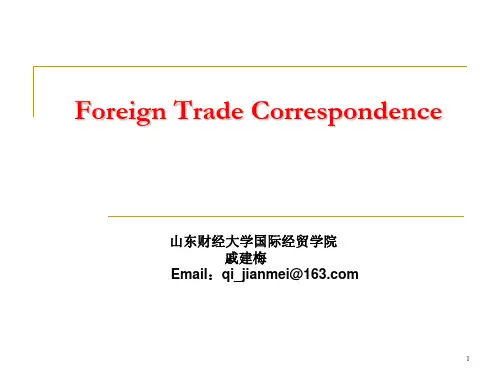
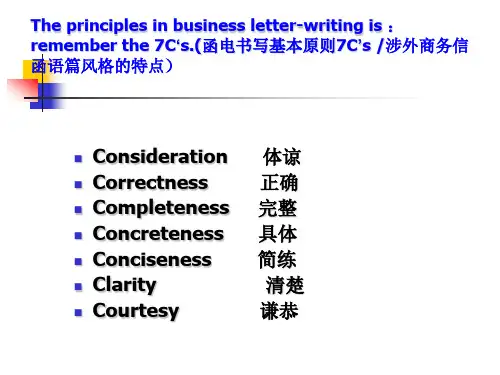
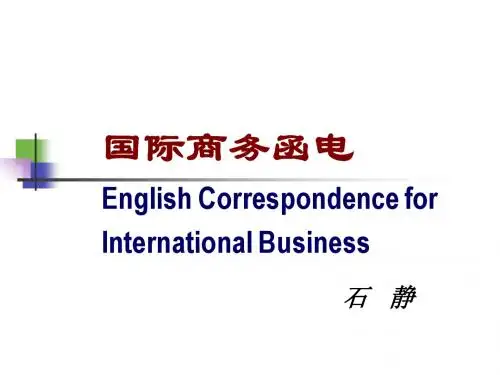

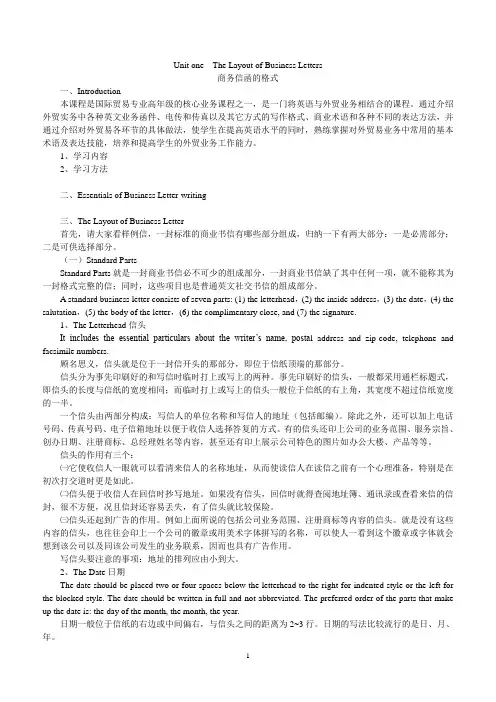
Unit one The Layout of Business Letters商务信函的格式一、Introduction本课程是国际贸易专业高年级的核心业务课程之一,是一门将英语与外贸业务相结合的课程。
通过介绍外贸实务中各种英文业务函件、电传和传真以及其它方式的写作格式、商业术语和各种不同的表达方法,并通过介绍对外贸易各环节的具体做法,使学生在提高英语水平的同时,熟练掌握对外贸易业务中常用的基本术语及表达技能,培养和提高学生的外贸业务工作能力。
1、学习内容2、学习方法二、Essentials of Business Letter-writing三、The Layout of Business Letter首先,请大家看样例信,一封标准的商业书信有哪些部分组成,归纳一下有两大部分:一是必需部分;二是可供选择部分。
(一)Standard PartsStandard Parts就是一封商业书信必不可少的组成部分,一封商业书信缺了其中任何一项,就不能称其为一封格式完整的信;同时,这些项目也是普通英文社交书信的组成部分。
A standard business letter consists of seven parts: (1) the letterhead,(2) the inside address,(3) the date,(4) the salutation,(5) the body of the letter,(6) the complimentary close, and (7) the signature.1、The Letterhead信头It includes the essential particulars about the writer’s name, posta l address and zip-code, telephone and facsimile numbers.顾名思义,信头就是位于一封信开头的那部分,即位于信纸顶端的那部分。

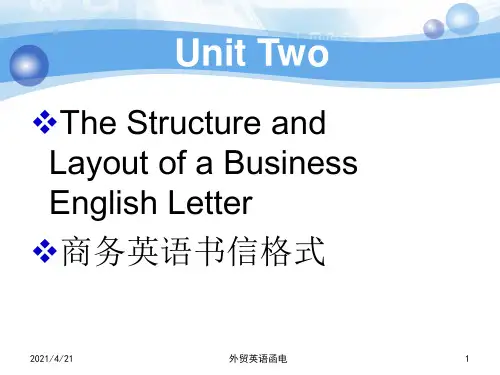
商务信函英语范文英文商务信函范文(一)起始用语 A.建立贸易关系 1.我们愿与贵公司建立商务关系。
2.我们希望与您建立业务往来。
3.我公司经营电子产品的进出口业务,希望与贵方建立商务关系。
例句: 1.We are willing to eatablish trade relations with your pany. 2.Please allow us to express our hope of opening an account with you. 3.This corporation is specialized in handing the import and export business in electronic products and wishes to enter into business relations with you. B.自我推荐 1.请容我们自我介绍,我们是……首屈一指的贸易公司。
2.本公司经营这项业务已多年,并享有很高的国际信誉。
3.我们的产品质量一流,我们的客户一直把本公司视为最可信赖的公司。
例句: 1.Let us introduce ourselves as a leading trading firm in… 2.Our pany has been in this line of business for many years and enjoys high international prestige. 3.Our products are of very good quality and our firm is always regarded by our customers as the most reliable one. C.推销产品 1.我们从……获知贵公司的名称,不知贵公司对这一系列的产品是否有兴趣。
2.我们新研制的……已推出上市,特此奉告。